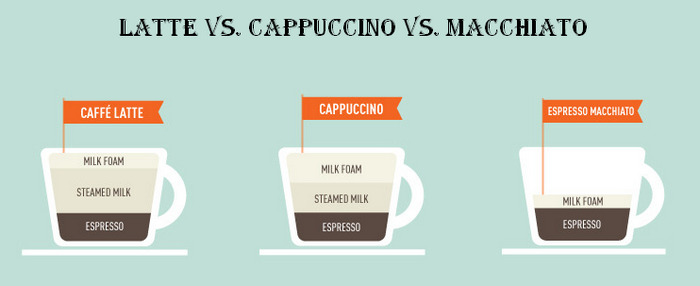What’s the Difference Between Latte, Cappuccino & Macchiato

Unless you’re a coffee aficionado or a skilled barista, it’s probably a bit confusing to tell the subtle differences between coffee drinks like latte, cappuccino and macchiato. Today, let’s stop referring to all specialty coffee drinks as lattes!
Espresso Based Drinks
Latte, cappuccino and machination, though they are different types coffee drinks, they also have something in common. All of them are espresso based drinks, which contains tow base ingredients, espresso and milk. Espresso and milk based drinks are great for people with sensitive stomach, as the milk tones down the coffee. (Tip: What’s the difference between espresso and coffee?)
Latte vs. Cappuccino vs. Macchiato

First learn the brief information about their difference from the following chart.
| Latte | Cappuccino | Macchiato | |
|---|---|---|---|
| Ingredients | 1 espresso + 1.5 or 4 steamed milk + 0.5 foamed milk | 1 espresso + 0.5 steamed milk + 1.5 foamed milk | 1 espresso + 0.5 foamed milk |
| Serving style | Latte is served in porcelain cups with better heat retention properties, at 240–600 ml. | Cappuccino is served in a glass on a saucer with a napkin, at 120 to 160 ml. | Macchiato is served in a demitasse cup, at 60 ml or 120 ml. |
| Originated in | America | Italy | Italy |
| Origin of name | In Italian “latte” is milk and caffè latte refers to coffee and milk. | The name “cappuccino” comes from Capuchin friars’ habits or their tonsured white heads surrounded by ring of brown hair. | The name “macchiato” stems from baristas show the waiters the difference between an espresso and an espresso with milk in; the latter was “marked” |
Latte

Latte, also known as Caffé Latte, which is an Italian term that means milk coffee. It’s a traditional way of drinking coffee, usually as part of breakfast in the home in Europe. And it Lattes started to gain popularity in the United States around the mid-1900s and got its commercial caffè version in American. Latte is well known for its swirled art into the foam on top of them. It has a special ratio of milk to espresso as below. Learn how to make latte at home without espresso machine.
- Double shot of espresso (60 ml)
- 90 ml or 240 ml of steamed milk
- 30 ml microfoam
Cappuccino

Cappuccino is a traditionally drink that is largely appreciated in the world. It is now composed of double shot of espresso and hot milk, topped with foamed milk. Also, it’s now common to see that it’s flavored with cinnamon or chocolate powder. Compared with a Latte, it’s smaller in volume and top with a thicker layer of micro foam. A cappuccino usually exceeds the height of the cup, making the foam visible above the side of the cup.The espresso to milk ratio of cappuccino shows below.
- Double shot of espresso (60 ml)
- 30 ml steamed milk
- 90 ml microfoam
Macchiato

Macchiato, meaning “stained” or “marked”, is an combination of espresso and foamed milk. It looks a small cappuccino at first sight, but it has a much stronger and aromatic taste. The milk is foamed directly into the espresso cup, which is then put under the coffee outlet. The drink is typically prepared by pouring one part of steamed milk directly into a shot of espresso.
- one or two shots (30 or 60 ml),
- 30 or 60 ml steamed milk with slight foam
After knowing the difference between Latte, Cappuccino and Macchiato, go to the coffee shop and order the one you like with confidence.
Related: 9 major types of coffee drinks explained
5 Homemade Iced Coffee Drinks for Summer
Why Does Cold Brew Coffee Have More Caffeine than Hot Coffee















